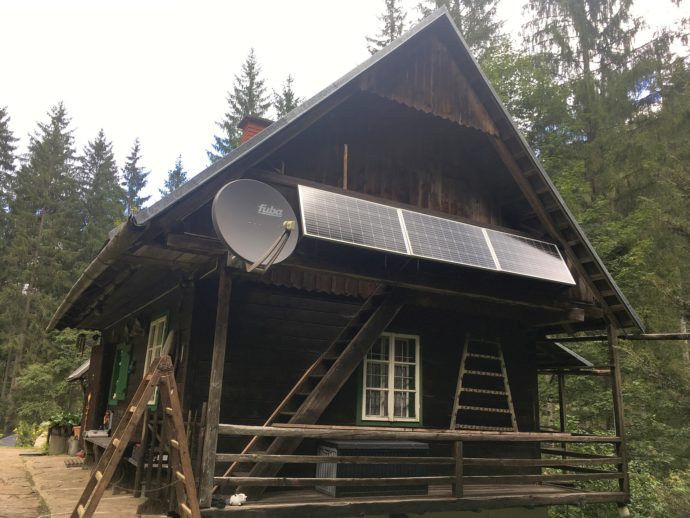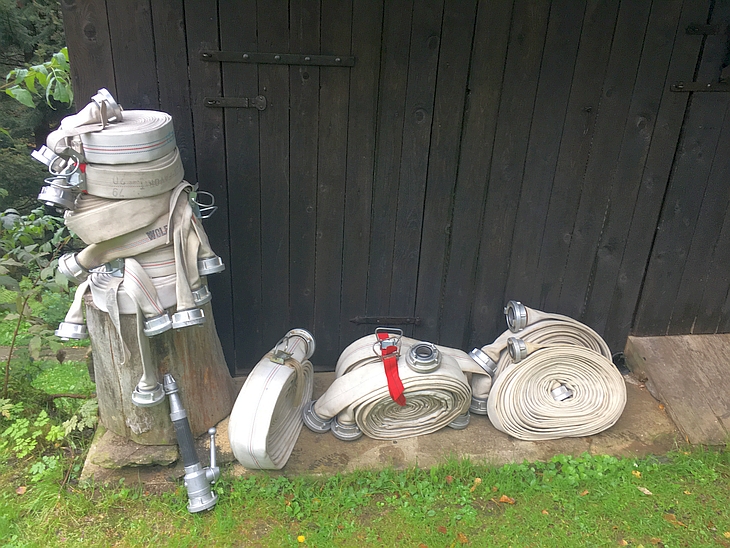
You could be forgiven for thinking Markus Pauritsch is a fireman in his day job. In fact he’s been an IT professional for the last fourteen years, working in their ten employee family business. In my experience IT types like to tinker in their spare time and Markus is no different. His DIY tinkering has led to an off-grid project which has inspired him to get more involved in renewable energy themes and hopefully expand their business into that area.
If ingenuity is anything to go by he’s certainly moving toward that goal – and to my mind takes first prize when it comes to using Victron products in unusual ways.
Now, what about those fire hoses?
An explanation
Let’s take a step back before we get to the test phase shown in the video above and the fully powered off-grid cabin. There was connector waterproofing and a lot more besides to be done before this gemütlich retreat could be enjoyed to the full. Gemütlich is a german word defined as having a feeling or atmosphere of warmth and friendliness – the classic cosy cottage – or in this case a log cabin in the forests of the Austrian Alps.
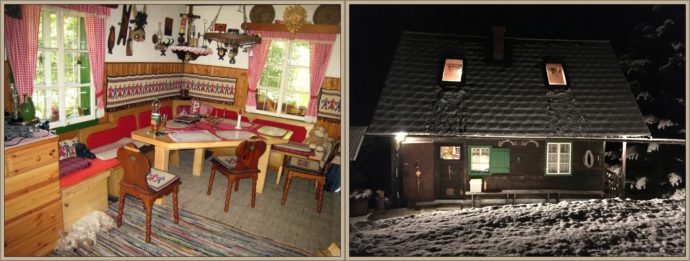
Cosy off-grid cabin although there can be up to a metre or more of snow in winter – a good job there’s a full hot water system and log fire to keep it all toasty.
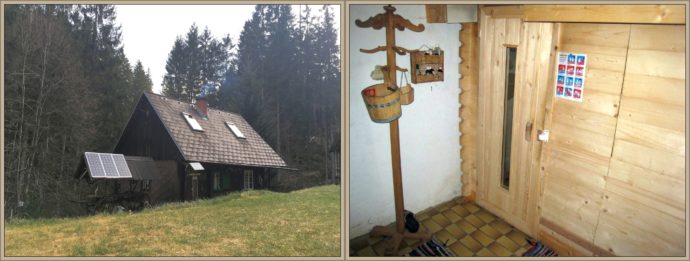
Solar power. The sun angle is not optimal during winter but yield in the summer is okay. Access to the log cabin (even in summer) requires a 4 x 4 – and after that challenging drive why not relax in the cabin’s sauna.
Austrian alps retreat
Markus bought the cabin from his grandfather in 2008, who originally bought it from some lumberjacks in the 70s. Over the years it was fully electrified, being powered by a Jenbach stationary diesel engine attached to a 5kVA generator. Flowing water from a spring (with that water heated by bottled gas) provides for a fully functional bathroom.
Besides the Jenbach generator, Markus built up a 12V uninterruptible battery power supply for radio, 4G internet (formerly Astra2Connect), SAT TV, charging mobiles and laptops, a water pump, and some lighting.
Victron solar – and hydro power?
To charge the UPS batteries Markus installed 700Wp of Victron Energy solar panels with a BlueSolar Charger MPPT 100/50.
It was naturally at this point that Markus got to know Victron Energy products and in particular their MPPT solar charge controllers. See this blog for matching solar modules to MPPT charge controllers and how they work. That got him thinking.
As Markus relates:
“I was amazed, how the Victron MPPTs worked – which prompted the question – could I get some Watts out of my stream?
Getting useable power from a water wheel became a very interesting possibility, but there was no information or knowledge available if anyone had done this with a Victron MPPT before. I thought I’d try and after some research I ordered a wind turbine generator (via Ebay) and a Pelton wheel water turbine.
I decided not to go the scientific way and calculate whatever needed to be calculated, instead I decided to go the ‘suck it and see’ way. First I got some fire hose from a friend of mine, over 200m of it! From the point where I wanted to place the wheel (200m upstream) I measured, with the help of digital geo services, a fall height of 40m. Rule of thumb calculations, along with hose losses, indicated a pressure of 3 to 3.5 bar and the real world pressure tests proved to be pretty good as you can see.
The fire hose supply and setting the discharge proved to be tricky though.
You have to have a static large volume supply and head to keep the hose filled and maintain the pressure. A cut up plastic water container collector was the cheapest and most effective solution to feed the hose. It has not moved an inch for many months now, even with heavy rain. When the water is high in the stream it simply flows over the edges as you can see.
After playing around with nozzle settings using washers, I got a stable water flow. After rectification of the 3 Phase AC coming out of the generator, I measured up to 135V DC with maximum water pressure applied to the Pelton wheel, with no electric load. Based on this I bought a BlueSolar Charger MPPT 150/35 and 2 big ripple capacitors of 160V 12,000 microfarads (μF) each. I did not test if they were needed or not as I just thought ‘hüfts nix schads nix’, which means if it doesn’t help it doesn’t make damage. In fact I think the caps are good for the Power Point Tracker circuit, as I would not like to receive much ripple voltage if I were a solar charge controller.
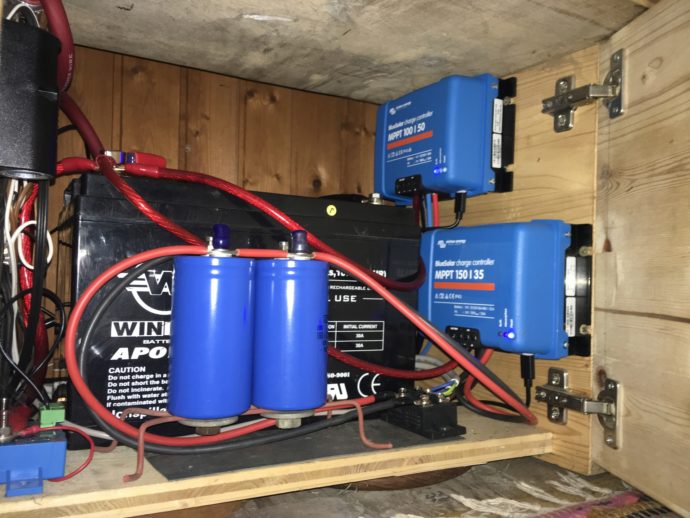
Components boxed up and ready to go. Note 65A BatteryProtect bottom left.
The results of this combination of components works great – with almost 200W continuous 12V charging power.
Here’s the hydro generator in operation.
I was very impressed once in full operation as you can see and hear how the MPPT works and searches for its power point when it is connected to the hydro generator. It works so smoothly and so fast, witnessed by the RPM being completely stable when the current draw is constant.”
AC power, components and system monitoring
- To feed the AC loads Markus installed a MultiPlus inverter/charger (12/3000/120-16).
- Conventional lighting was changed to LEDs, decreasing the power used from 700W to 170W whilst providing far more useable light.
- To monitor the battery a BMV-700 was installed.
After thinking about how to monitor the Victron devices, Markus came across the Venus Raspberry Pi project. With the support of the super helpful Venus Dev Mailing list he got the Pi running with Venus and local touchscreen, thanks to Izak Burger and Jings. You can read more about Izak and his project in this blog post: Raspberry Pi running Victron’s Venus firmware.
The Raspberry Pi with Venus and local touch display connects to Victron’s VRM via a 4G connection using a Huawai Modem/Router which is so stable and reliable, that it is just scary I’m told. It has been online 24/7 for months with no interruption. It has a Li-ion battery, so it is independent from the power source for a few hours in case of interruption.
Markus certainly had some luck with local LTE coverage as the A2 motorway is but 2km away and LTE is supplied to the motorway – so he doesn’t even need external 4G antennas to connect to it. Previously he had Astra2Connect, but it was very expensive and the latency was particularly bad.
Enhancements and the future
It’s important to note this is not the final stage of the project, as the above is primarily proof of concept. For instance, a vacuum stable hose is far better for this application as it will get far more water flow in comparison to a firehose, and as a result more Watts out. However that is also a matter of cost as a vacuum stable, freeze capable, 80mm hose is around 4 to 5 Euro per metre – and with 230m required you can get a firehose by comparison very cheaply, as they get sorted out and retired by the fire departments after a time. Decisions, decisions.
Here’s some future enhancements that Markus has planned:
- Use a better, vacuum stable hose.
- Improved ‘dirt management’ at the water feed barrel as leaves and small stones are problematic.
- Improved housing for the Pelton wheel and ‘wind’ generator.
- Improved cable management.
- Generator integration or maybe the Jenbach needs to retire as a standby solution, after a period of over 60 years of good service!
- Dashboard for Touch VenusPi and BMV and much more…
Conclusion
This hydro power solution all works beautifully, using ingenuity to keep the costs down and prove that BlueSolar Charger MPPTs can equally be called BlueHydro Charger MPPTs!
My thanks go to Markus Pauritsch for the information and images used in this blog – we salute his ingenuity and passion for getting his project up and running. If you have any questions for him do leave a comment in Disqus below.
I hope this pre festive season blog seeds ideas of how you might use Victron Energy products in 2018. In the meantime we wish you a fun and festive holiday.
John Rushworth

